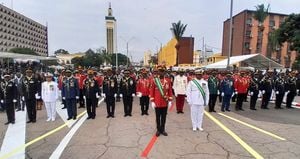Miss Universe 2024 National Costume Show Captivates Audiences
The much anticipated night of the Miss Universe 2024 National Costume Show delivered on its promise of spectacle and cultural celebration, with contestants from 125 countries showcasing their national pride. With costumes reflecting rich histories, folklore, and representations of each contestant’s homeland, it was more than just a beauty pageant—this was a vivid display of global culture and creativity.
This year’s event took place against the vibrant backdrop of Mexico, where the expertise of designers and the uniqueness of each culture burst forth on stage. Each of the 103 contestants stepped onto the runway adorned not only with elaborate costumes but with stories tied to their attire. From designs inspired by nature to historical icons, the National Costume segment was filled with impactful narratives embodying the diversity of the global community.
Among the standout performances was Marianela Ancheta from Cuba, whose costume was modeled after Oshún, the Yoruba goddess revered for love and beauty. Adorned with peacock feathers and sunflowers, Ancheta’s attire echoed Cuba's request for resilience and hope, reminiscent of Oshún's nurturing character and cultural importance. The choice of yellow and gold not only dazzled but also signified pride, as she paid homage to her heritage.
Dominican Republic’s Celinee Santos brought to life the Caribbean’s beauty with her stunning clamshell-inspired costume, representing the sparkling waters surrounding her homeland. This display of deep blues and shimmering pearls showcased both elegance and confidence, capturing the audience’s admiration as she flowed gracefully across the stage.
Egyptian contestant Logina Salah transported viewers back to ancient times with her interpretation of Cleopatra, complete with metallic beadwork and artistic depictions of pyramids and the Sphinx. The costume celebrated not only the country’s glorious civilization but also tied it back to modern beauty and strength. Salah’s eye-catching look was complemented by traditional makeup, enhancing the connection to her country’s historic legacy.
From the ancient landscapes of Egypt to the tropical beauty of Guyana, Ariana Blaize represented her nation by channeling the spirit of Kai, the indigenous chief who exemplified peace and sacrifice. With feathered wings and powerful symbolism, Blaize’s display was not just about showcasing her attire but bringing recognition to her cultural roots.
India’s Rhea Singha embraced the essence of prosperity, stepping out dressed as the Golden Eagle. This exquisite ensemble signified wealth and affluence, bridging the past glories of the Gupta civilization with the promise of future greatness. Singha’s radiant gold attire reflected the magnificence of her country, earning her spot among the top costumes of the night.
Maria Fernanda Beltran Figueroa, representing the pageant’s host country, donned the attire of Chalchiuhtlicue, the Aztec goddess of water. Her costume brought the essence of Mexican celebrations alive, crafted from dazzling feathers and colors to represent joy and festivity. Figueroa was not just representing herself but the rich traditions and stories woven through Mexico’s heritage.
Victoria Velasquez Vincent of New Zealand showcased her rich cultural background with her costume inspired by the native fantail bird. The collaboration between Filipino and Māori designers birthed a beautiful representation of conservation and protection—a nod to the strong connection between people, nature, and their shared responsibilities as guardians.
Continuing the theme of homage, Tati Calmell from Peru channeled the sun god Inti, embodying warmth and radiance with her dazzling golden attire. The ensemble not only glittered under the stage lights but also commanded attention as she highlighted the power of Peruvian culture and the luminosity of tradition.
Philippines’ representative, Chelsea Manalo, with her costume titled “Hiraya,” offered viewers a spectacular fusion of faith and culture. By embodying elements of both Christianity and Islam, Manalo’s ensemble was not only visually impressive but narratively rich, bridging the historical ties between the Philippines and Mexico. Her innovative headdress, styled as the Galleon Trade ship, underscored the importance of faith and history, establishing her as one of the night’s shining stars.
Lastly, Zimbabwe’s Sakhile Dube wowed the audience with her eagle-inspired costume, aptly named The Soaring Eagle. Symbolizing vision and strength, Dube’s spectacular display connected her garment directly to the country’s majestic natural landscapes, echoing pride and heritage as she commanded the runway.
This year’s Miss Universe National Costume Show truly became a celebration of identity, creativity, and cultural storytelling. Each costume — from jubilant to enlightening — spoke volumes not just about the beauty of the contestants but also about the nations they represent. The evening left attendees and viewers alike reverberated with the rich tapestries of stories told through fabric, feathers, and creativity, showing the world just how beautiful diversity can be.
Miss Universe 2024 Showcases National Heritage and Cultural Grandeur
With 2024 bringing together 125 contestants, the Miss Universe pageant served as the perfect palette for celebrating the beauty found within various cultures. Each outfit, uniquely crafted, provided insight not only about the contestant's country but also about the artistry and imagination behind cultural interpretations.
Besides the established favorites, several contestants surprised the audience with ingenious designs incorporating elements from local folklore, nature, and modern references. For example, Miss Nicaragua, Geyssell García, showcased her national pride with her vibrant costume honoring the León Cathedral, demonstrating the depth of connection between culture, history, and creativity.
Representing different global aspects, contestants like Ileana Marquez Pedroza of Venezuela emerged almost as if from the tombs of the Amazon, cloaked in lush greens and themed textures, paying tribute to the biodiversity of the region. Alongside her walked Maya Turdalieva from Kyrgyzstan, whose outfit celebrated the grace of the snow leopard, exemplifying beauty and resilience. Such intelligent designs bridged the gap between tradition and future, forming narratives bound by the shared experience of communities across borders.
Contestants like Miss India and Miss Sri Lanka did not hold back either; Rhea Singha with her bird-inspired ensemble, and Melloney Dassanayake with reverberations of traditional landmarks, respectively, illustrated not just garments but history. Each costume, no matter how embellished or understated, wove personal and national stories together, inviting the audience to look beyond the visual and explore the 'why' behind the craft.
Even lesser-known talents showcased their creative potential. Miss Netherlands, Faith Landman, with her ceramic-themed dress, infused elements of Dutch craftsmanship, creating dialogue around cultural identities, transformation, and art.
This year’s Miss Universe National Costume Show was about more than just the stunning attire; it represented the very essence of belongingness and identity. It reminds us all of how rich, vibrant, and diverse our world truly is, inviting us to embrace and celebrate our differences. Every costume was not merely fabric or feathers but rather threads of heritage, histories alive on the runway, rooting each contestant not only to their country but to the universal quest for unity and recognition.
Given the significance of the event and its impact on global perspectives, it’s easy to see why the National Costume Show at Miss Universe 2024 has captured hearts. It united audiences with storytelling like no other, and now all eyes will be on the final competition to see who will wear the coveted crown, representing the intertwined stories of culture, beauty, and tradition on an international stage.



